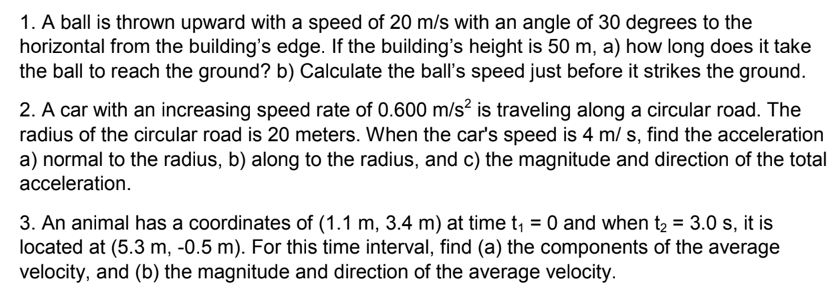horizontal from the building's edge. If the building's height is 50 m, a) how long does it take the ball to reach the ground? b) Calculate the ball's speed just before it strikes the ground.
horizontal from the building's edge. If the building's height is 50 m, a) how long does it take the ball to reach the ground? b) Calculate the ball's speed just before it strikes the ground.
Physics for Scientists and Engineers
10th Edition
ISBN:9781337553278
Author:Raymond A. Serway, John W. Jewett
Publisher:Raymond A. Serway, John W. Jewett
Chapter4: Motion In Two Dimensions
Section: Chapter Questions
Problem 17P: A boy stands on a diving board and tosses a stone into a swimming pool. The stone is thrown from a...
Related questions
Concept explainers
Topic Video
Question

Transcribed Image Text:1. A ball is thrown upward with a speed of 20 m/s with an angle of 30 degrees to the
horizontal from the building's edge. If the building's height is 50 m, a) how long does it take
the ball to reach the ground? b) Calculate the ball's speed just before it strikes the ground.
2. A car with an increasing speed rate of 0.600 m/s? is traveling along a circular road. The
radius of the circular road is 20 meters. When the car's speed is 4 m/ s, find the acceleration
a) normal to the radius, b) along to the radius, and c) the magnitude and direction of the total
acceleration.
3. An animal has a coordinates of (1.1 m, 3.4 m) at time t, = 0 and when t2 = 3.0 s, it is
located at (5.3 m, -0.5 m). For this time interval, find (a) the components of the average
velocity, and (b) the magnitude and direction of the average velocity.
Expert Solution
This question has been solved!
Explore an expertly crafted, step-by-step solution for a thorough understanding of key concepts.
This is a popular solution!
Trending now
This is a popular solution!
Step by step
Solved in 2 steps with 2 images

Knowledge Booster
Learn more about
Need a deep-dive on the concept behind this application? Look no further. Learn more about this topic, physics and related others by exploring similar questions and additional content below.Recommended textbooks for you

Physics for Scientists and Engineers
Physics
ISBN:
9781337553278
Author:
Raymond A. Serway, John W. Jewett
Publisher:
Cengage Learning

Physics for Scientists and Engineers with Modern …
Physics
ISBN:
9781337553292
Author:
Raymond A. Serway, John W. Jewett
Publisher:
Cengage Learning

College Physics
Physics
ISBN:
9781285737027
Author:
Raymond A. Serway, Chris Vuille
Publisher:
Cengage Learning

Physics for Scientists and Engineers
Physics
ISBN:
9781337553278
Author:
Raymond A. Serway, John W. Jewett
Publisher:
Cengage Learning

Physics for Scientists and Engineers with Modern …
Physics
ISBN:
9781337553292
Author:
Raymond A. Serway, John W. Jewett
Publisher:
Cengage Learning

College Physics
Physics
ISBN:
9781285737027
Author:
Raymond A. Serway, Chris Vuille
Publisher:
Cengage Learning

Physics for Scientists and Engineers, Technology …
Physics
ISBN:
9781305116399
Author:
Raymond A. Serway, John W. Jewett
Publisher:
Cengage Learning

College Physics
Physics
ISBN:
9781305952300
Author:
Raymond A. Serway, Chris Vuille
Publisher:
Cengage Learning

College Physics
Physics
ISBN:
9781938168000
Author:
Paul Peter Urone, Roger Hinrichs
Publisher:
OpenStax College